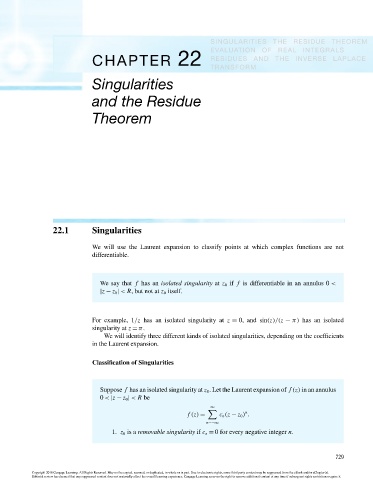Page 749 - Advanced_Engineering_Mathematics o'neil
P. 749
SINGULARITIES THE RESIDUE THEOREM
EVALUATION OF REAL INTEGRALS
CHAPTER 22 RESIDUES AND THE INVERSE LAPLACE
TRANSFORM
Singularities
and the Residue
Theorem
22.1 Singularities
We will use the Laurent expansion to classify points at which complex functions are not
differentiable.
We say that f has an isolated singularity at z 0 if f is differentiable in an annulus 0 <
|z − z 0 | < R, but not at z 0 itself.
For example, 1/z has an isolated singularity at z = 0, and sin(z)/(z − π) has an isolated
singularity at z = π.
We will identify three different kinds of isolated singularities, depending on the coefficients
in the Laurent expansion.
Classification of Singularities
Suppose f has an isolated singularity at z 0 . Let the Laurent expansion of f (z) in an annulus
0 < |z − z 0 | < R be
∞
n
f (z) = c n (z − z 0 ) .
n=−∞
1. z 0 is a removable singularity if c n = 0 for every negative integer n.
729
Copyright 2010 Cengage Learning. All Rights Reserved. May not be copied, scanned, or duplicated, in whole or in part. Due to electronic rights, some third party content may be suppressed from the eBook and/or eChapter(s).
Editorial review has deemed that any suppressed content does not materially affect the overall learning experience. Cengage Learning reserves the right to remove additional content at any time if subsequent rights restrictions require it.
October 14, 2010 15:37 THM/NEIL Page-729 27410_22_ch22_p729-750

